This is our step-by-step guide on how to dehydrate Zatarain’s Jambalaya Rice.
Zatarain’s Jambalaya Rice is a preseasoned mix of rice and spices with a Creole or Cajun flair.
By cooking and dehydrating this jambalaya rice mix, we now have a major ingredient to whip up any variety of Cajun recipes. Additionally, the dehydrated rice becomes more like instant rice. It rehydrates and cooks much faster and requires significantly less fuel when cooking in the field or at the campsite.
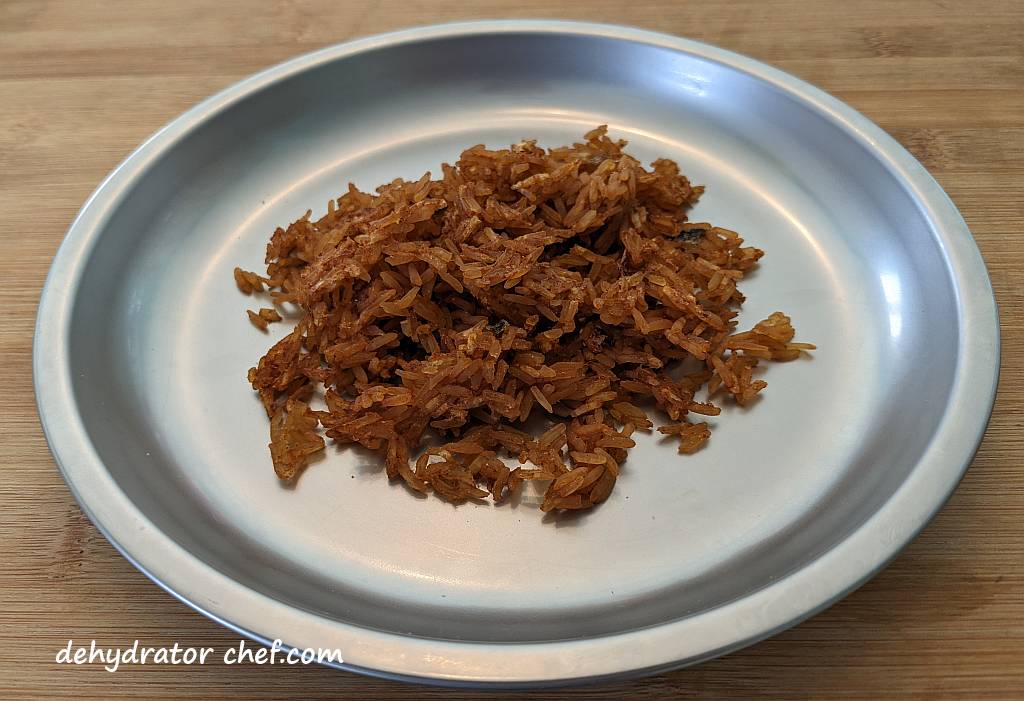
Even if you’ve never dehydrated anything before, don’t worry; dehydrating Zatarain’s Jambalaya Rice is a simple process that anyone can do with just a few basic tools that we will discuss here.
So, let’s get started dehydrating a box of Zatarain’s Jambalaya Rice.
Table of Contents
- How to Dehydrate Zatarain’s Jambalaya Rice
- Supplies Needed for Dehydrating Zatarain’s Jambalaya Rice
- Step 1. Process the Zatarain’s Jambalaya Rice for Dehydrating
- Step 2. Preparing the Dehydrator for Zatarain’s Jambalaya Rice
- Step 3. Dehydrating the Zatarain’s Jambalaya Rice
- Step 4. When is the Dehydrated Zatarain’s Jambalaya Rice Done
- Step 5. Equalizing and Conditioning Dehydrated Zatarain’s Jambalaya Rice
- Step 6. Storing Dehydrated Zatarain’s Jambalaya Rice
- Hydration
- Weights, Measures, and Serving Sizes
- Insider Tips
How to Dehydrate Zatarain’s Jambalaya Rice
You will need a good quality food dehydrator to dehydrate Zatarain’s Jambalaya Rice. We use the Nesco FD-75A, and you can check out our food dehydrator guide here and why we think Nesco offers the best bang for the buck. We believe this is the best food dehydrator for our long-term food storage needs.
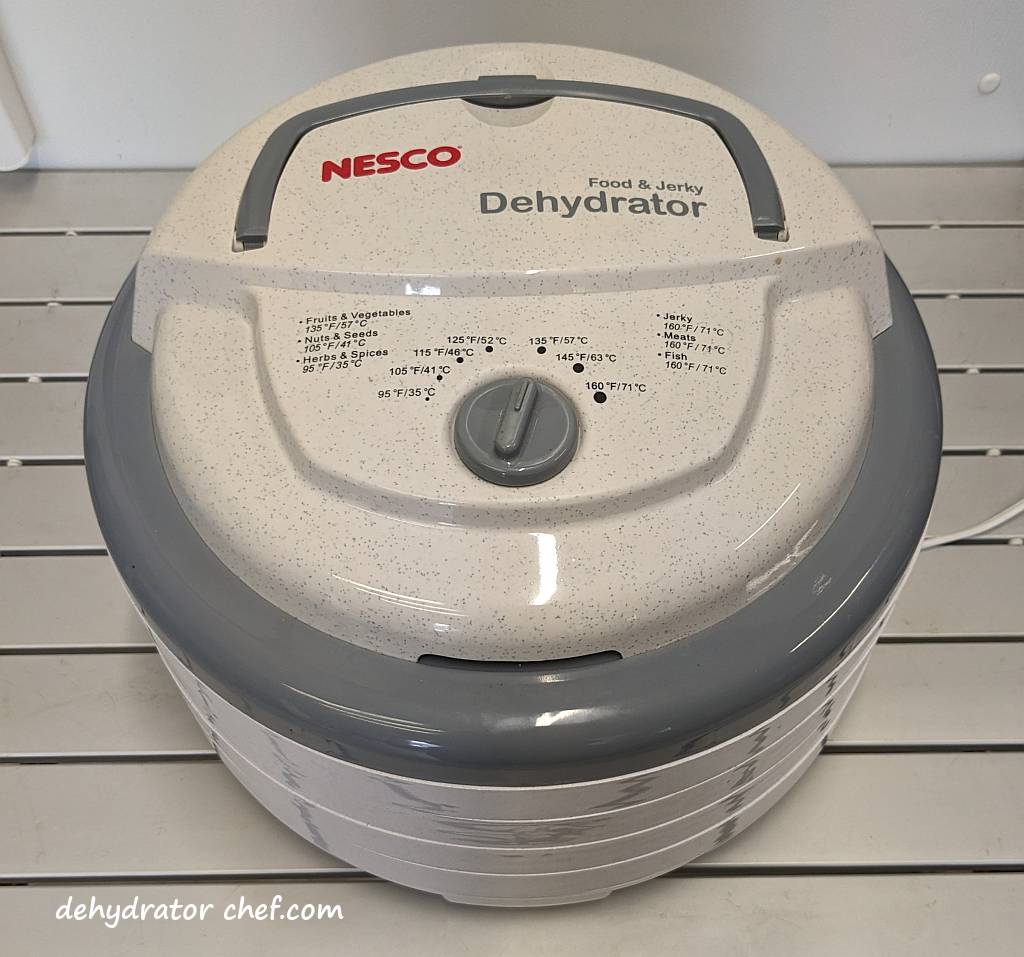
Supplies Needed for Dehydrating Zatarain’s Jambalaya Rice
- A box or two of Zatarain’s Jambalaya Rice
- Food dehydrator with removable fruit roll sheet inserts, one for each tray
- Standard kitchen tools, including cutting boards, chef’s knife, spatula, etc.
- Clear canning jars with tight-fitting lids
- Wide-mouth canning jar funnel
- Desiccant packets
For planning purposes, one 8-ounce box of cooked Zatarain’s Jambalaya Rice will fill four Nesco FD-75A 13.5-inch round dehydrator trays.
Step 1. Process the Zatarain’s Jambalaya Rice for Dehydrating
We will start by cooking the rice according to the stovetop directions printed on the box with a few tweaks. We’re not going to add any meats or any oils.
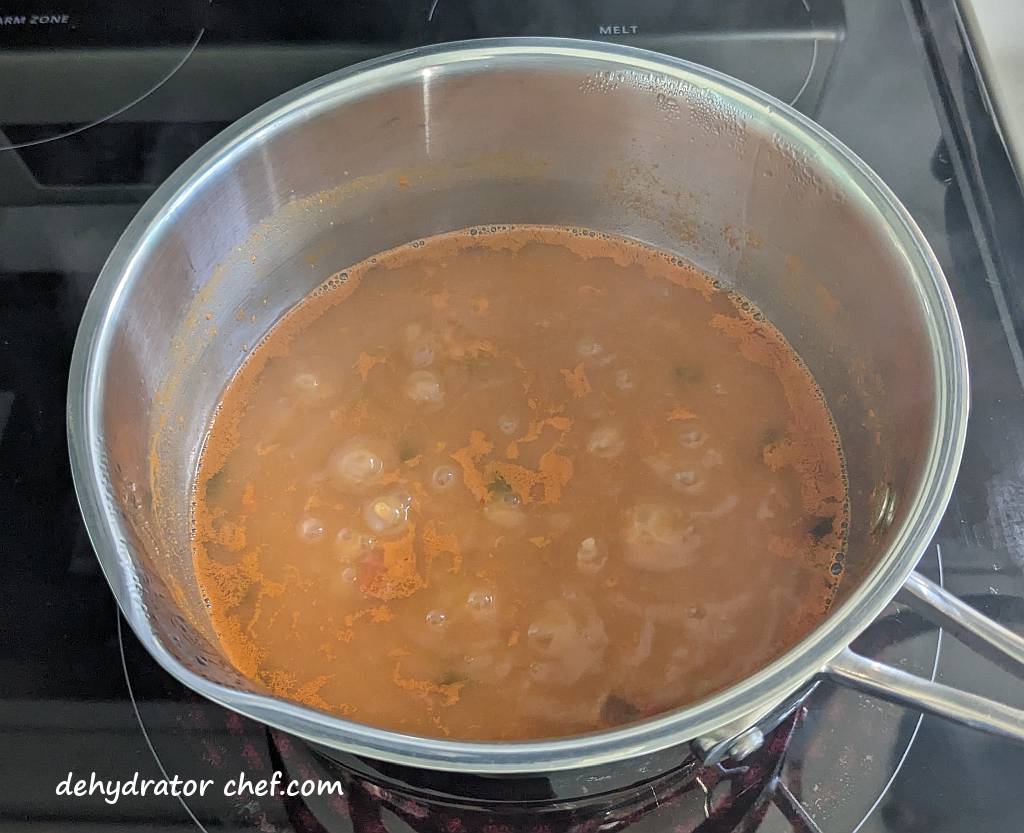
First, we’re inspecting the rice mix for anything that doesn’t look like it belongs there.
Generally, the modified cooking process is to mix the measured amount of water and the jambalaya rice mix in a 3-quart saucepan until well blended. Then, bring to a boil. Once boiling, reduce the heat to low and cover the saucepan. Simmer for 25 minutes or until the rice is tender.
Step 2. Preparing the Dehydrator for Zatarain’s Jambalaya Rice
We cooked the entire 8-ounce box of Zatarain’s Jambalaya Rice as described above in Step 1.
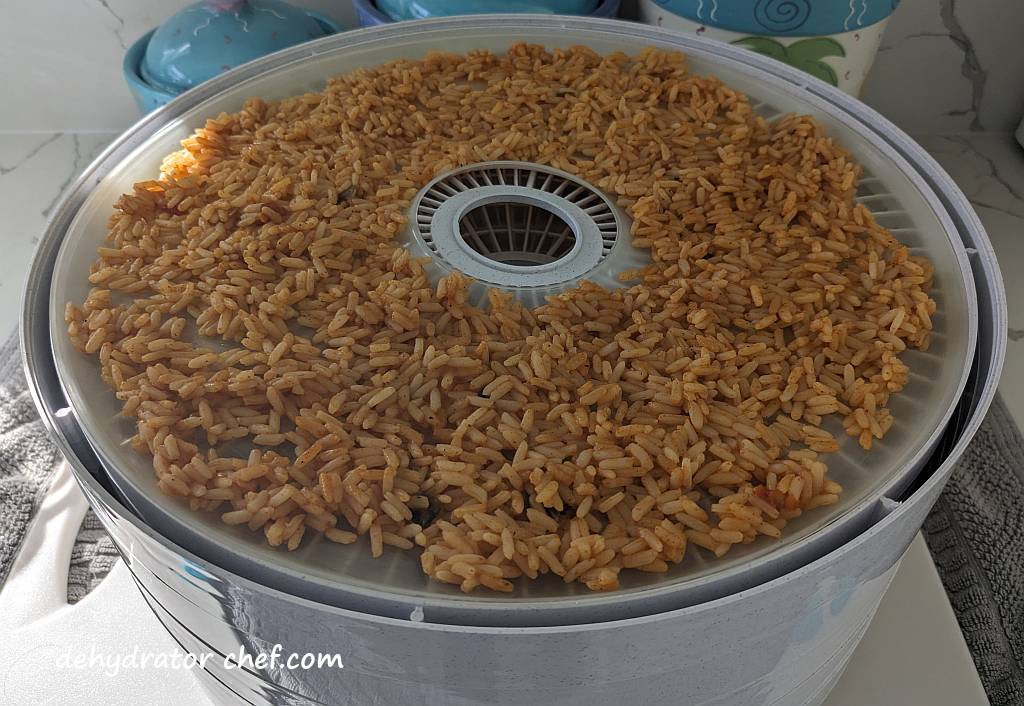
One cup of cooked Zatarain’s Jambalaya Rice will fill one Nesco FD-75A dehydrator trays with the removable fruit roll sheet insert.
The Nesco 13.5-inch round dehydrator tray has close to 119 square inches or .8 square feet of surface area for drying.
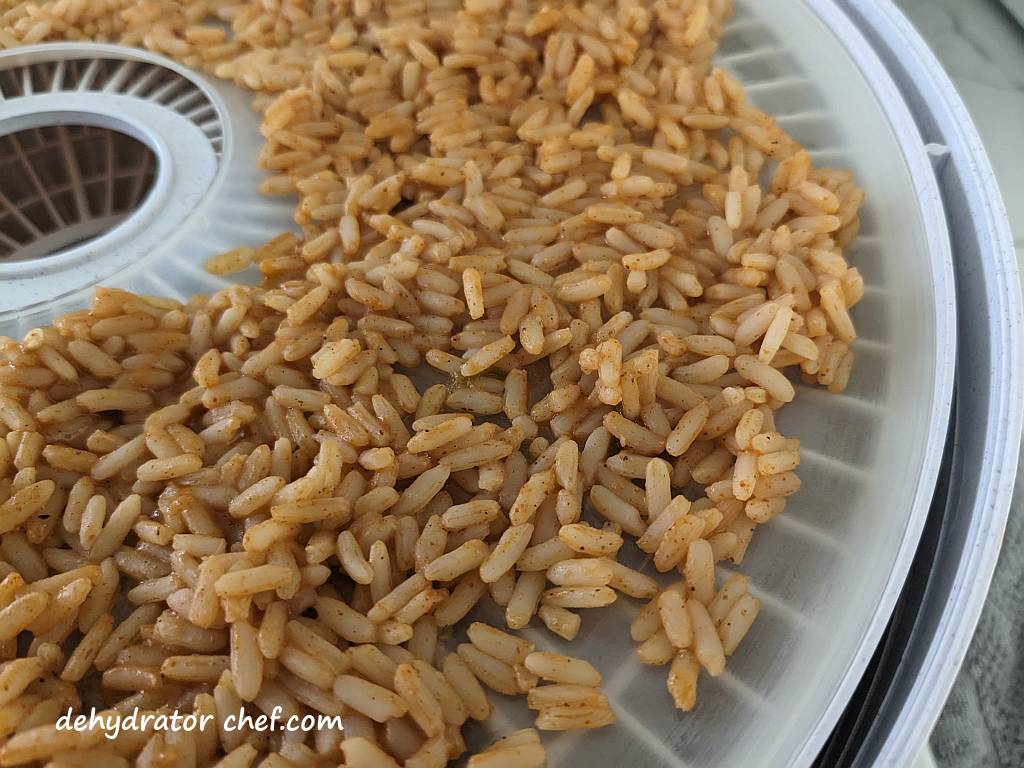
Spread the cooked jambalaya rice into a thin layer to promote even drying. A spatula works well here. The cooked rice will most likely stick together in clumps as you layer it on the fruit roll sheets. We can fix the clumping problem later.
Step 3. Dehydrating the Zatarain’s Jambalaya Rice
Set the dehydrator thermostat temperature to 135 °F / 57 °C. I find that 18 to 24 hours is about the right amount of time for dehydrating rice. Drying times are variable and dependent on your food dehydrator, the ambient temperature and humidity, the number of dehydrator trays, the size of food items, and how crowded you fill your dehydrator trays.
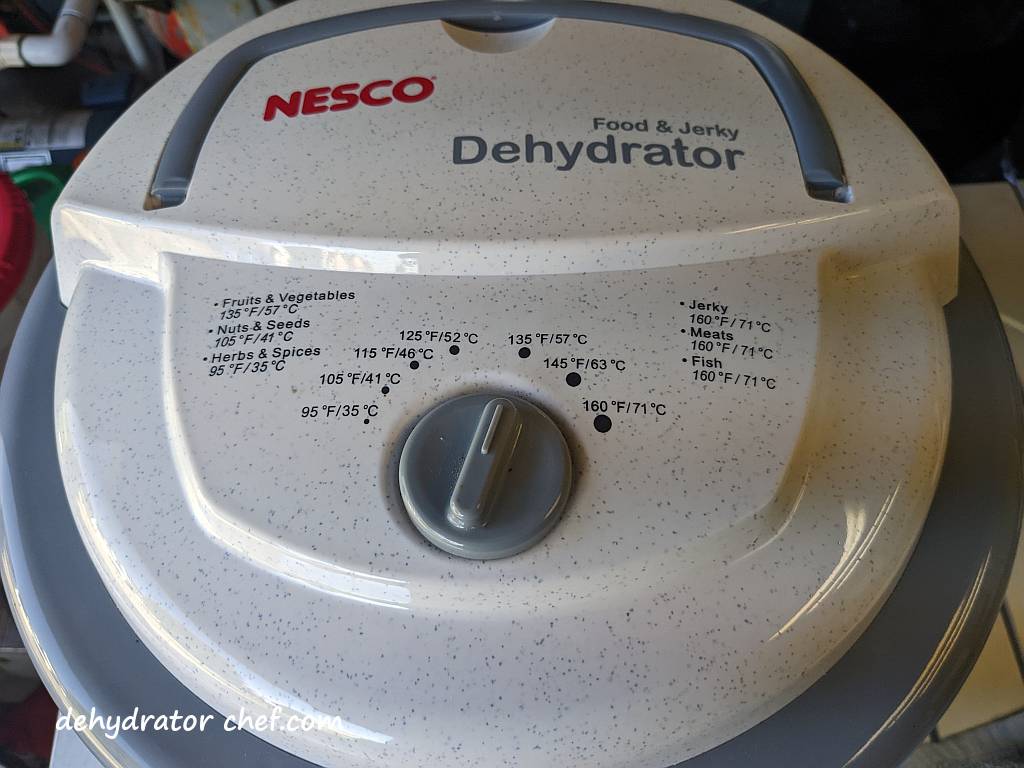
Case hardening is a phenomenon that can occur during the drying process of certain foods, including rice. It refers to the development of a hard outer crust or surface layer on the food, which can prevent the escape of moisture from the interior. This can lead to uneven drying and potentially result in moisture retention within the rice grains.
The outer layer of the jambalaya rice clumps may dry quickly and prevent the inside moisture from escaping, otherwise known as case hardening. About mid-way through the drying process, break apart any rice clumps into smaller pieces to prevent case hardening.
Step 4. When is the Dehydrated Zatarain’s Jambalaya Rice Done
The dehydrating jambalaya rice will tend to shrink and break apart into sections. Pick up and examine both the top and bottom, looking for any sign of moisture or areas of undried rice. If seen, just let it dehydrate for another few hours and check again.
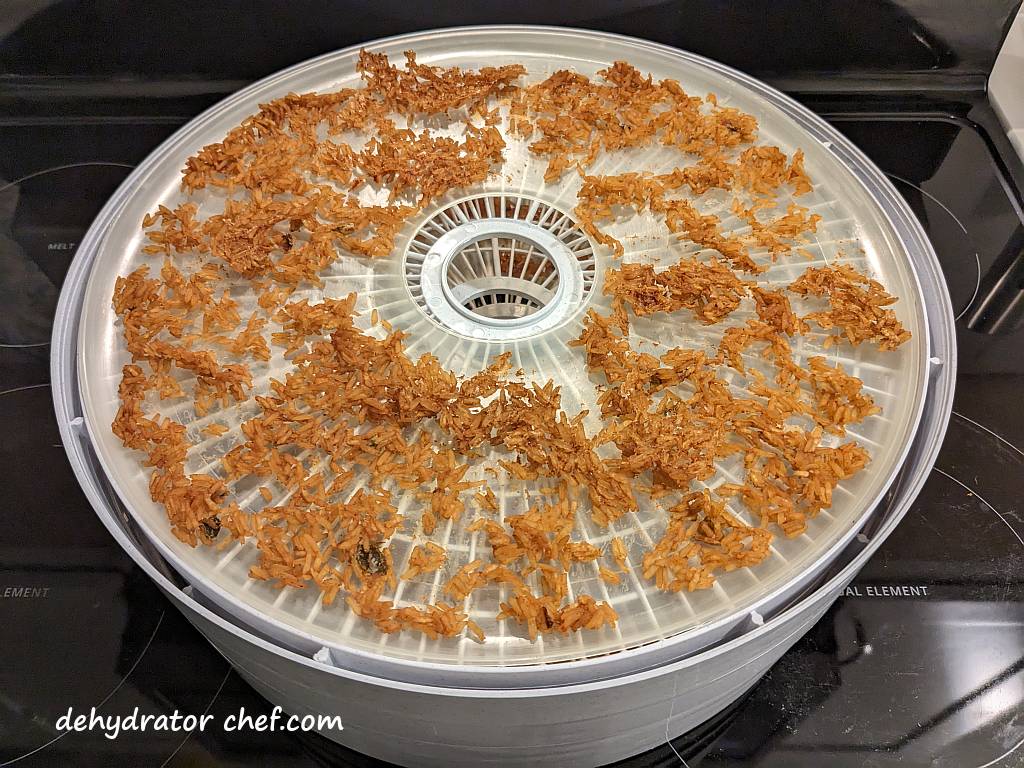
Drying times depend on your food dehydrator, the ambient temperature and humidity, the number of dehydrator trays, the size of food items, and how crowded you fill your dehydrator trays. Refer to your dehydrator owner’s manual for recommended temperatures and times for dehydrating specific foods. Remember to use drying times as a guide.
Dehydrated Zatarain’s Jambalaya Rice is done when it easily breaks apart into smaller pieces. Any clumps have been broken down and checked for dryness and case hardening.

With experience, you’ll develop an eye for this, but until it develops, just check it all for dryness.
Step 5. Equalizing and Conditioning Dehydrated Zatarain’s Jambalaya Rice
When the dehydrated rice pieces are removed from the dehydrator, the remaining moisture may not be distributed equally among the pieces because of their location and position in the dehydrator. Equalizing and conditioning is a procedure for freshly dehydrated foods that ensures any residual moisture remaining in any piece is spread or equalized among all the other pieces in the batch. Let the dried jambalaya rice equalize and condition in the storage container for 7 to 10 days.
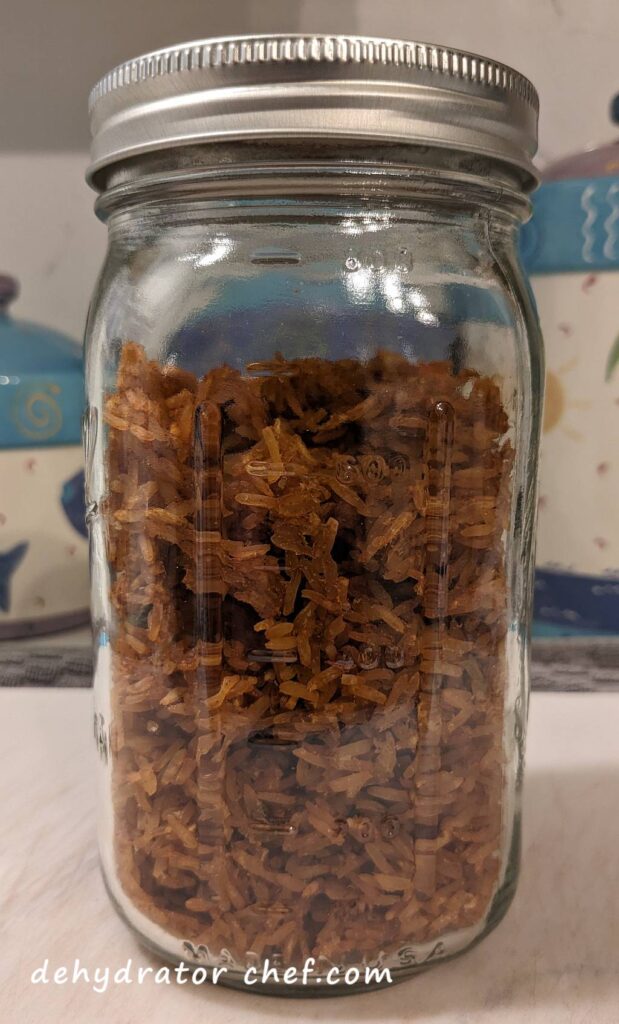
We always recommend letting food items cool completely after they have finished dehydrating and before packing them into an airtight storage container for equalizing and conditioning. Warm food may cause sweating, which could provide enough moisture for mold to grow.
Dehydrated food items do not take long to start hydrating from naturally occurring household humidity. Do not leave dehydrated food items exposed to the elements any longer than necessary because of the increased risk of mold growth.
After a short cooling period, loosely pack the dehydrated Zatarain’s Jambalaya Rice into a clean, dry, insect-proof, and airtight storage container. We use the larger quart-size canning jars for conditioning.
Since the canning jars are clear, it’s easy to see what’s inside. Fill the jars at most 2/3 to 3/4 full, leaving some headspace.
Headspace is the distance between the food surface and the lid’s underside. Its purpose is to provide ample space for the dehydrated food product to slide and tumble when shaken and rotated to expose any evidence of clumping or sticking.
A quality stainless steel or plastic canning funnel makes the messy job of getting dehydrated foods off the dehydrator tray removable inserts and into the canning jars an easy task. Take a minute or two and check them out here on Amazon.
Every day, check the jar for moisture. Roll the jar contents around and note any clumping or sticking. If seen, put the contents back on the dehydrator for several more hours. Since canning jars are clear, it’s easy to see what’s inside.
Lastly, if you notice any mold, even the tiniest bit, throw it all out. The mold spores you see are blooming enough to make them visible. But there are more, even smaller mold spores in the rest of your jar that make your dehydrated food inedible. Toss it all out and start another batch.
Step 6. Storing Dehydrated Zatarain’s Jambalaya Rice
Use an appropriately sized canning jar for storage. The dehydrated Zatarain’s Jambalaya Rice might keep up to 12 months or longer. Exactly how long depends on how well you dehydrate the jambalaya rice mix and your dried-food pantry storage conditions.
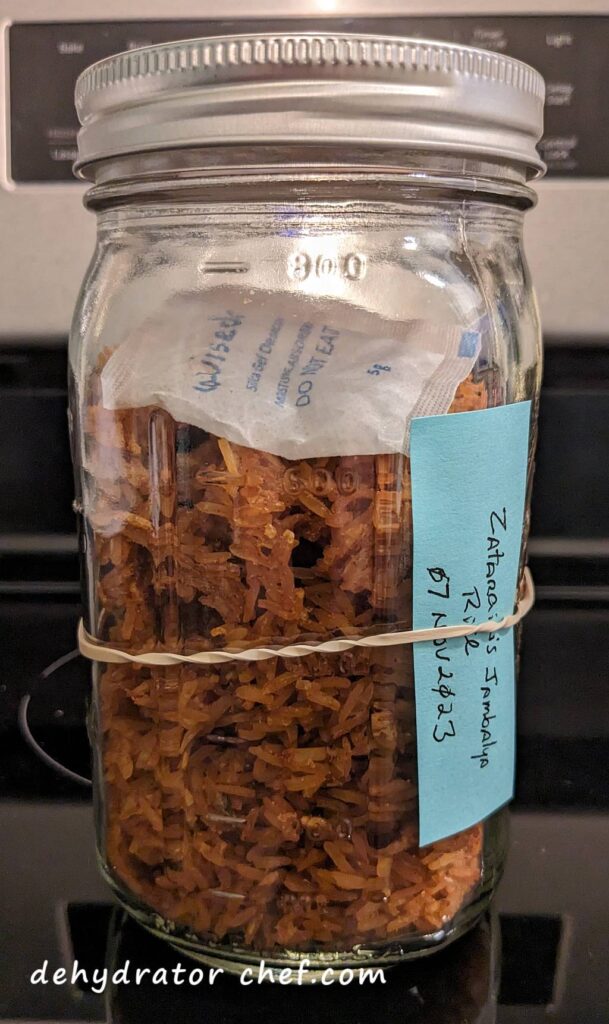
We’ll use a food-safe desiccant packet for moisture control because we live in a fairly humid area. For our pint-size or quart-size mason jars, we’ll use a single food-safe 5-gram desiccant packet. The desiccant packets will absorb any moisture and extend the shelf life of the dehydrated jambalaya rice.
We use these inexpensive food-safe desiccant packets, which are available from Amazon. These 5-gram packets have over 5000 of mostly 4- and 5-star customer reviews, with an average of 4.7 stars out of 5. Our bag of 60 desiccant packets will last quite a while because they can be recharged and reused multiple times. Other food-safe sizes are available.

I don’t use a desiccant packet for moisture control during the equalizing and conditioning phase in Step 5. Doing so might mask moisture issues should the food items not be adequately dried.
Attach or include a short note describing the contents and the date the product was dehydrated. The note also informs us where to go in the dehydrator logbook to make another note.
Hydration
Hydrate the dried Zatarain’s Jambalaya Rice using roughly a 1-to-1 ratio of dehydrated rice mix to boiled water. Plan on at least 15 to 20 minutes to fully hydrate.
Weights, Measures, and Serving Sizes
This information is summarized from our notes in a logbook on most of our food dehydration efforts.
On average, the contents from one 8-ounce box of Zatarain’s Jambalaya Rice mix are close to what is printed on the box, 226 grams.
Cooking process: mixed the measured 2-1/2 cups of water and the jambalaya rice mix in a 3-quart saucepan, then stirred until it was well blended. Next, brought the mix up to a boil. Once boiling, reduced the heat to low and cover the saucepan. Simmered for about 25 minutes until the rice was tender.
On average, a batch of cooked jambalaya rice weighs 735 grams.
Dehydrated, the average weight is 220 grams.
There are five servings in one 8-ounce box of Zatarain’s Jambalaya Rice mix.
Cooked and dehydrated, the serving size is about 45 grams.
| Zatarain’s Jambalaya Rice – 8 ounce box | Average weights |
|---|---|
| uncooked jambalaya rice mix – 8 ounce box | 226 grams |
| cooked jambalaya rice mix | 735 grams |
| total dehydrated weight | 220 grams |
| dehydrated weight per serving | 45 grams |
Insider Tips
Besides the homemade dehydrated meal recipes on this website, try adding the dried jambalaya rice mix to any of your favorite freeze-dried food pouches for a bit more flavor, bulk, and calories. I don’t know about you, but with some of those store-bought freeze-dried meals, I am still hungry. I need a bit more to fill me up.
Practice these Dehydrator Chef homemade dehydrated camping meal recipes at home several times with the very same outdoor kitchen gear used in the field or at the campsite. This approach lets you practice your skills to know what to expect and where to adapt.
